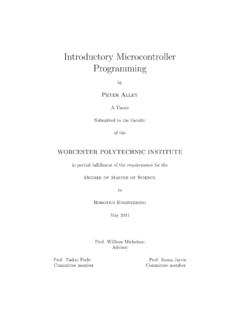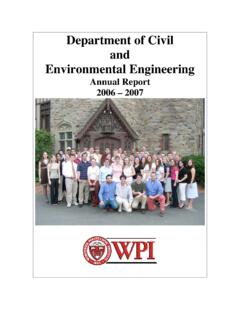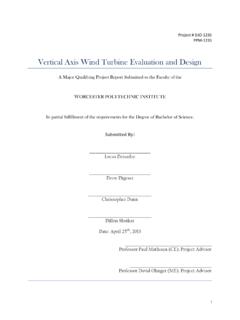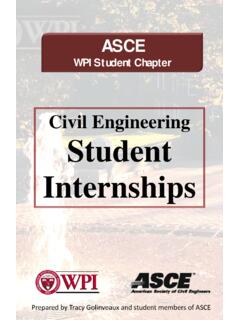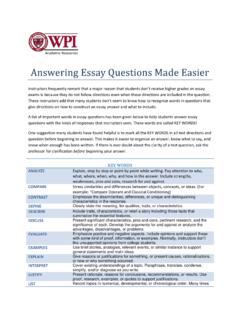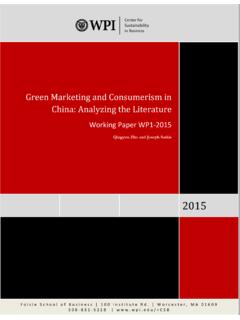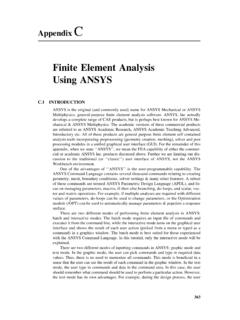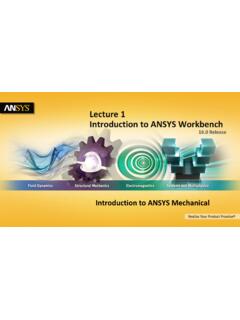Transcription of Heat Sealing Fundamentals, Testing, and Numerical Modeling
1 Heat Sealing Fundamentals, Testing, and Numerical Modeling A Major Qualifying Project Submitted to the Faculty Of the WORCESTER POLYTECHNIC INSTITUTE In Partial Fulfillment of the Requirements for the Degree of Bachelor of Science By _____ Meghan Cantwell _____ Jason Cardwell _____ Melanie Cantwell _____ Bradford Davison _____ Cody Gonyea April 30th, 2015 _____ Professor Diana A. Lados, Advisor _____ Professor Cosme Furlong, Co-Advisor 1 Abstract Heat Sealing is a critical process related to product packaging. Understanding the effects of controlling process parameters on seal quality and product integrity is essential in package design, establishing manufacturing protocols, and verification of seal effectiveness and consistency. The material combinations used in specific packaging applications and their interactions with the thermal and physical conditions of the process will dictate the final quality of the seal. To optimize these conditions for selected materials, comprehensive knowledge of the process itself is needed in combination with supporting computational and experimental tools.
2 using fundamentals of heat transfer, 1D/2D Numerical models were created in MATLAB and ansys to predict temperature distributions within important material layers and evaluate seal adhesion. Computational models were validated using an original experimental methodology and set-up designed and built by the team. Ultimately, a unique framework to assess and index the overall seal quality in actual industrial settings was delivered. 2 TABLE OF CONTENTS 1 Introduction .. 7 Problem Statement .. 7 Objectives .. 7 Approach and Methodology .. 7 2 Background Research .. 9 Process Overview .. 9 Blister Forming Methods .. 9 Sealing 11 ASTM Standards .. 13 Materials .. 16 Paperboard .. 16 Adhesives .. 17 Polymers .. 18 Thermosets vs Thermoplastics .. 19 Common 19 Amorphous Polyethylene Terephthalate (aPET) .. 20 Aluminum .. 22 Heat Transfer in Relation to Heat Sealing .. 24 Conductive Heat Transfer.
3 24 Transient Heat Transfer .. 26 Free Convection .. 29 Heat Diffusion Equation .. 29 3 Analytical 33 Initial Heat Transfer Configuration .. 33 Numerical Solution .. 35 MATLAB Interpretation .. 38 Two-Dimensional Model .. 40 4 Computational Studies .. 43 Structural Study .. 43 Thermal 44 Press Heat Loss Study .. 44 3 Experimental Heating Study .. 45 5 Experimental Methods .. 48 Manufacturing of Equipment .. 48 Modification of Press Model .. 48 Fabrication of Testing Rig .. 50 Case Studies .. 52 Devices Used for Experiment .. 52 Experimental Procedure Overview: .. 53 Detailed Experimental Procedure .. 54 6 Results and Discussion .. 56 Validation of MATLAB Predictions .. 56 Development of Seal Quality Scale .. 59 Subjective 59 Optical Quantification and Analysis .. 60 Determination of Seal Quality Scale .. 61 Seal Strength Quality Equation .. 63 7 Conclusions and Future Work .. 65 8 Bibliography.
4 66 9 Appendices .. 68 Two-Dimensional MATLAB Code .. 68 Three-Dimensional MATLAB Code .. 71 4 LIST OF FIGURES Figure 1: An overview of the heat Sealing process.. 9 Figure 2: Examples of types of blister packaging.. 9 Figure 3: An example of blister packaging.. 10 Figure 4: Examples of thermoformed packages.. 10 Figure 5: An example of a heat sealed package.. 11 Figure 6: An example of a heat Sealing device.. 11 Figure 7: An example of a cold Sealing process.. 12 Figure 8: An example of RF Sealing .. 12 Figure 9: Examples of ASTM Testing Procedures.[18].. 14 Figure 10: ASTM standard for adhesive peel test.[18] .. 15 Figure 11: The Mer structures of PP, PE and PS.. 18 Figure 12: An example of molecular chains.. 18 Figure 13: Mer structure representation of PVC.. 19 Figure 14: Mer structure representation of aPET.. 20 Figure 15: Esterification reaction with water byproduct.. 21 Figure 16: Transesterification reaction with methanol byproduct.
5 21 Figure 17: (a) Aluminum 6061, 550 x 50 pancake grain structure, (b) The microstructural phases of Aluminum 6061.. 24 Figure 18: An explanation of Fourier s law.. 24 Figure 19: Heat transfer relevant to the Sealing process.. 25 Figure 20: Physical representation of contact resistance.[8] .. 26 Figure 21: Transient heat transfer through multiple layers.[8] .. 28 Figure 22: 1D representation of conduction through multiple layers.. 33 Figure 23: Heat transfer of package system.. 34 Figure 24: Various press surfaces temperatures vs time from the two-dimensional model corresponding to press temperatures of (a) 120C, (b) 160C, (c) 200C.. 40 Figure 25: (a) 118C Nodes 18 and 19, (b) 120C Nodes 18 and 19, (c) 120C Node 18, (d) 120C Node 19.. 41 Figure 26:(a) 158 C Nodes 18 and 19, (b) 160 C Nodes 18 and 19, (c) 160 C Node 18, (d) 160 C Node 19.. 42 Figure 27: (a) 198 C Nodes 18 and 19, (b) 200 C Nodes 18 and 19, (c) 200 C Node 18, (d) 200 C Node 19.
6 42 Figure 28: (a) Von-Mises stresses and (b) Strain gradient through the layers of the package.. 43 Figure 29: Original press heat 44 Figure 30: Temperature gradient of press after 25 min.. 46 Figure 31: Maximum press temperature vs time for the press via ansys .. 46 Figure 32: Temperature gradient of bottom of press.. 47 Figure 33: The modified press (left) next to the initial press design (right). The blue highlighted section represents the plastic to paperboard interface that is the focus of the experiments.. 49 Figure 34: The entire modified press, including the holes allowing for the cartridge heater inserts. The important surface interface is highlighted in blue.. 50 5 Figure 35: CAD drawings of cutouts.. 51 Figure 36: (a) Machined press surface, (b) Press and base attached to Instron load frame.. 51 Figure 37: Plots of various surface temperatures for both MATLAB and experimental trials and a plot of percent differences for all surface temperatures.
7 (a) MATLAB 120C, (b) MATLAB 160C, (c) MATLAB 200C, (d) experimental 120C, (e) experimental 160C, (f) experimental 200C, (g) plot of percent differences.. 57 Figure 38. The three levels shown in a seal: (a) Level 0, (b) Level 1, and (c) Level 2.. 59 Figure 39: (a) Example of colored seal, (b) An example of the seal are analysis performed under the image analyzing equipment.. 60 Figure 40. The macro and microscopic views of the three different seal levels.. 61 Figure 41: (a) Pressure versus seal quality, (b) Time versus seal quality, (c) Temperature versus seal quality.. 63 6 LIST OF TABLES Table 1: Material vs. acoustic impedance value [19] .. 16 Table 2: Heat Sealing relevant properties of SafePak 18pt .. 17 Table 3: Other properties of SafePak 18pt .. 17 Table 4: Properties of Pentaform SmartCycle Ridge APET TH-Es135R .. 22 Table 5: Properties for Roll Stock ecostarTM Bio-HS 1000 (multilayer) .. 22 Table 6: Aluminum 6061 element concentrations in weight %.
8 23 Table 7: Variables from Bi and Fo Equations .. 27 Table 8: Boundary and initial conditions for transient 28 Table 9: Heat transfer equation variables .. 30 Table 10: MATLAB array construction parameters .. 39 Table 11: Temperature gradient using a customized MATLAB script .. 41 Table 12: List of operations and 51 Table 13: Trial runs for all temperature, time and pressure parameters .. 54 Table 14: Values of percent differences for various press surface temperatures .. 58 Table 15: Specifications of the seal quality index .. 61 Table 16: The seal quality and process parameters of each experimental run .. 62 LIST OF EQUATIONS Equation 1: 1D Transient heat 28 Equation 2: Heat conduction rate in x dimension.. 30 Equation 3: Heat conduction rate in y dimension.. 30 Equation 4: Heat conduction rate in z dimension.. 30 Equation 5: Conduction equation with conservation of energy.. 30 Equation 6: General heat diffusion equation.. 31 Equation 7(a) and 7(b): Heat diffusion equation with constant thermal diffusivity.
9 31 Equation 8: 2D heat diffusion equation with no internal heat generation.. 32 Equation 9: Finite difference approximation of the x dimension.. 35 Equation 10: Finite difference approximation of the y dimension.. 36 Equation 11: Finite difference approximation of the time dimension.. 36 Equation 12: Finite difference representation of x dimensional partial derivative.. 36 Equation 13: Finite difference representation of x dimensional partial derivative.. 37 Equation 14: Finite difference approximation of the heat diffusion equation in two Equation 15: Percent difference formula.. 56 Equation 16. A modified version of the steady state resistance equivalence that accounts for contact resistance between layers.. 59 Equation 17: Equation for seal quality prediction.. 64 7 1 INTRODUCTION PROBLEM STATEMENT Heat transfer is a widely studied aspect of engineering and is a fundamental concept in many engineering applications. Heat transfer can be used to explore solutions everywhere from fire protection and turbomachinery to aerospace and packaging.
10 Understanding the core concepts in heat transfer can lead to safer, more efficient, and more economic products and solutions. Fortunately, in this day in age there are quite a few software packages capable of properly Modeling the transfer of heat and energy in a system, given accurate inputs. With the input of accurate values and interactions, such software can facilitate a more thorough understanding of the mechanical and thermal behavior seen in the above-mentioned range of applications. The concept of heat transfer is widely understood in the engineering community. However, a more scarce understanding exists in regards to the behavior of thermal energy while under the influence of several variables simultaneously and in such a precise time and length scale. The sponsoring company seeks out a more fundamental understanding of the how the process variables seen in their packaging process relates to the output of their final products. OBJECTIVES The main objectives of this MQP are to further understand how the variable process parameters of the heat Sealing process affect the quality of seal of the Sponsor s packages.
